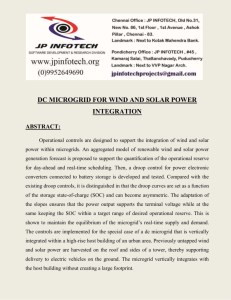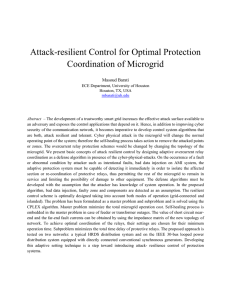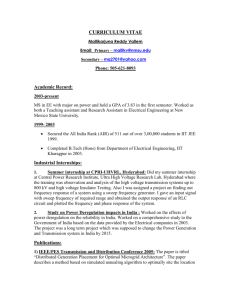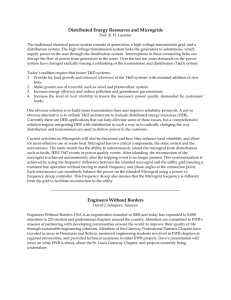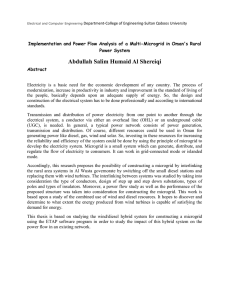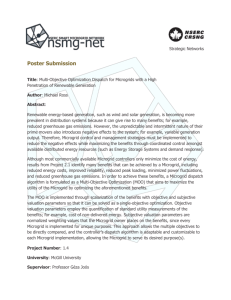What is a Microgrid?
advertisement
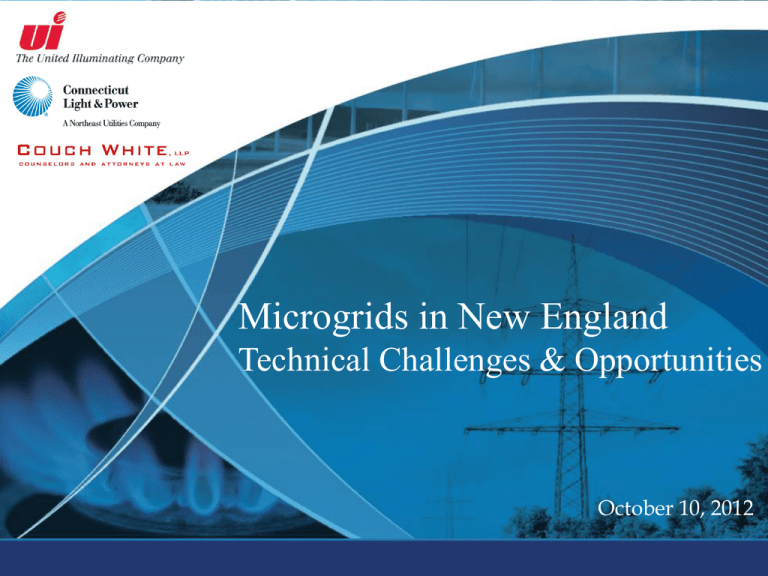
Microgrids in New England Technical Challenges & Opportunities October 10, 2012 Agenda I. What is a Microgrid? • • II. Examples Elements to Consider Why a Microgrid? • • • Improved Reliability Utility Guiding Principals Role of the Utility III. Technical and Regulatory Considerations • Microgrid Grant and Loan Program IV. Questions/Discussion 1 Agenda I. What is a Microgrid? • • II. Examples Elements to Consider Why a Microgrid? • • • Improved Reliability Utility Guiding Principals Role of the Utility III. Technical and Regulatory Considerations • Microgrid Grant and Loan Program IV. Questions/Discussion 2 What is a Microgrid? Definition of a Microgrid: Means a group of interconnected loads and distributed energy resources within clearly defined electrical boundaries that acts as a single controllable entity with respect to the grid and that connects and disconnects from such grid to enable it to operate in both gridconnected or Island Mode. (As defined in Public Act 12-148§7) 3 Typical Distribution System Typical Distribution Substation CL CL Typical Distribution Circuit(s) Approximately 8 - 15 Miles Long Serving approximately 1,000 – 5,000 customers CL CL Critical Load Customer Load 4 Typical Emergency Generation Typical Distribution Substation CL CL Typical Distribution Circuit(s) Approximately 8 - 15 Miles Long Serving approximately 1,000 – 5,000 customers CL CL Critical Load Customer Load Generator 5 Typical Overhead Infrastructure Microgrid Typical Distribution Substation CL CL Typical Distribution Circuit(s) Approximately 8 - 15 Miles Long Serving approximately 1,000 – 5,000 customers C C CL CL Critical Load Customer Load REMARKS: Generator C Breaker Closed 1. Generators operational during normal and emergency conditions. 2. Overhead infrastructure that allows export of power to grid. 3. Drawing does not include required communication control layer and microgrid management system. 6 Typical Underground Infrastructure Microgrid Typical Distribution Substation SW SW CL CL Typical Distribution Circuit(s) Approximately 8 - 15 Miles Long Serving approximately 1,000 – 5,000 customers C C CL Critical Load CL SW Customer Load REMARKS: Generator C SW Breaker Closed Switch 1. Generators operational during normal and emergency conditions. 2. Underground infrastructure that allows export of power to grid. 3. Each critical load connected to a switch. 4. Drawing does not include required communication control layer and microgrid management system. 7 Example of Critical Load Locations 8 Electric Distribution Company Distribution System • Representative locations of critical facilities • Colored lines represent actual circuits with approximately 8 MVA of load. Elements to Consider • Managing a Microgrid is like managing a very small vertically integrated electric utility without a transmission component but with generation and distribution components • System configuration must be known at all times and be factored into normal grid switching and operating protocols by both the distribution company and the company operating Microgrid interconnection Characteristics: • Has Distributed Resources and load • Ability to disconnect and parallel with distribution system • Intentional and planned islanding 9 Technical and Operational Considerations Technical: • • • • • Proper control of voltage/frequency /power quality Protection schemes and modifications Technical Changes in power-flow magnitude and direction Steady state and transient conditions Reserve margins, load shedding, demand response, and cold load pickup Operational: • • • • • • Safety – Lockout/tag-out Protection coordination Load to generation matching Load (phase) imbalance Microgrid communications, monitoring and dispatch (mini EDC) Ongoing maintenance 10 Economic Considerations…balancing cost and reliability Reliability Cost Key Considerations: • • • • • • • Geographic dispersion of critical loads Initial cost to install required facilities Life of installed system may vary and is important Monitoring and control of installed system Maintenance and troubleshooting of installed system Generation must be capable of continuous operation (weeks) Non-Microgrid and Microgrid customer impacts 11 Agenda I. What is a Microgrid? • • II. Examples Elements to Consider Why a Microgrid? • • • Improved Reliability Utility Guiding Principals Role of the Utility III. Technical and Regulatory Considerations • Microgrid Grant and Loan Program IV. Questions/Discussion 12 Improved reliability To achieve high reliability during an extreme weather event; the following must be taken into account in addition to the technical and operational considerations discussed previously: • Facilities serving the Microgrid are most reliable if constructed underground • Provide adequate and reliable generation • Access to an uninterruptable fuel source for the generator • Generator must poses black start capability • Generator must be able to follow load 13 Utility’s Guiding Principles • Ensure the safety of customers and utility employees at all times • Maintain distribution system grid reliability • Microgrids are viewed as a potential grid resiliency tool • Microgrids must increase reliability for its customers • Non Microgrid customers will not be adversely impacted • Microgrid costs allocated in a balanced approach • Operationally sound • Capable of intentional islanding on demand and automatically • Capable of return to normal grid supply without adversely impacting customers 14 Role of the Utility • • • • • • Perform feasibility evaluation under the DEEP Phase 1 RFP for submitted projects Accept Microgrid projects Interconnection Application Review projects in accordance with the Generator Interconnection Fast Track and Study Process (“Guidelines”) Execute a standard Operating Agreement between Microgrid owner and utility that will define the roles and responsibilities for the installation, operation and maintenance of the Microgrid during normal and abnormal system conditions. Protection coordination with grid distribution system infrastructure Participation in development of Microgrid standards and guidelines 15 Agenda I. What is a Microgrid? • • II. Examples Elements to Consider Why a Microgrid? • • • Improved Reliability Utility Guiding Principals Role of the Utility III. Technical and Regulatory Considerations • Microgrid Grant and Loan Program IV. Questions/Discussion 16 Microgrid Grant and Loan Pilot Program • The CT Microgrid Program developed by Department of Energy and Environmental Protection (DEEP) • Envisions Three Types of Microgrid Projects: − Repurpose Existing Distributed Generation − Reconfigure Existing Distributed Generation − New Generation • Total Amount of Grants and Loans Awarded Not to Exceed $15 million • Grants and Loans Awarded to Selected Projects to Assist With: − Cost of Design − Engineering Services − Interconnection Infrastructure Technical and Regulatory Considerations Will a Project Conflict with Existing Utility Franchise Rights or be Regulated as a Utility? • In general, to address franchise concerns, unless the Microgrid is located entirely on private property, the incumbent electric utility would own the wires utilized by the developer. Technical and Regulatory Considerations How Will a Microgrid Project be Interconnected? Directly to the Grid? What Voltage? • Each project will be evaluated individually. However, developers should follow the existing interconnection procedures – Guidelines for Generator Interconnection Fast Track and Study Processes dated May 12, 2010. The size and/or voltage of a project will dictate whether the participation and involvement of ISO-NE is required. Technical and Regulatory Considerations Will the Microgrid Power Be Fed into the Grid or Serve its Own Customers Directly? • The individual project design will dictate where power flows. When connected in parallel with the electric distribution system, behind customer’s meter, the Microgrid can serve its customer loads, and also potentially export any excess energy produced through existing net metering provisions. • When the Microgrid separates from the electric distribution system, the Microgrid would only serve the customer loads for which it has been designed. Technical and Regulatory Considerations Will the Developer Be Charged Separately for Using the Utility Distribution System? • Yes. The charges will be determined by the applicable tariff. Technical and Regulatory Considerations Will an Operational Agreement be Required? • Yes. Currently, however, no standard agreement is yet available. Technical and Regulatory Considerations What Operational Obligations Will Be Required? • The generation source will need to respond quickly and run continuously for an extended period of time with the ability to balance load and generation. No specific operational obligations have yet been developed. Technical and Regulatory Considerations How Will the Load be Metered? • The specific metering configuration will be determined on an individual project basis. In general, submetering is permitted in Connecticut only in limited circumstances. In any event, the Developer will be responsible for ensuring the load is supplied. Technical and Regulatory Considerations Who Will Own the Power Delivered into the Grid? • When and how title to the power is transferred has not yet been developed. How this is determined may impact the final design configuration of individual projects. Technical and Regulatory Considerations How Will the Developer be Paid for the Power Supplied? • The payment mechanism is still unclear at this stage. Options include market pricing, as well as bi-lateral agreements. Technical and Regulatory Considerations Who Pays the Developer for the Power? • The answer to this question will depend on both the individual Microgrid design, as well as when title to the power transfers and to whom. Questions/Discussion… Jim Mader, Senior Project Manager; UI jim.mader@uinet.com Einat Dorobantzu, Manager Technology Integration; CL&P einat.dorobantzu@nu.com Jim King, Partner; Couch White, LLP jking@couchwhite.com

